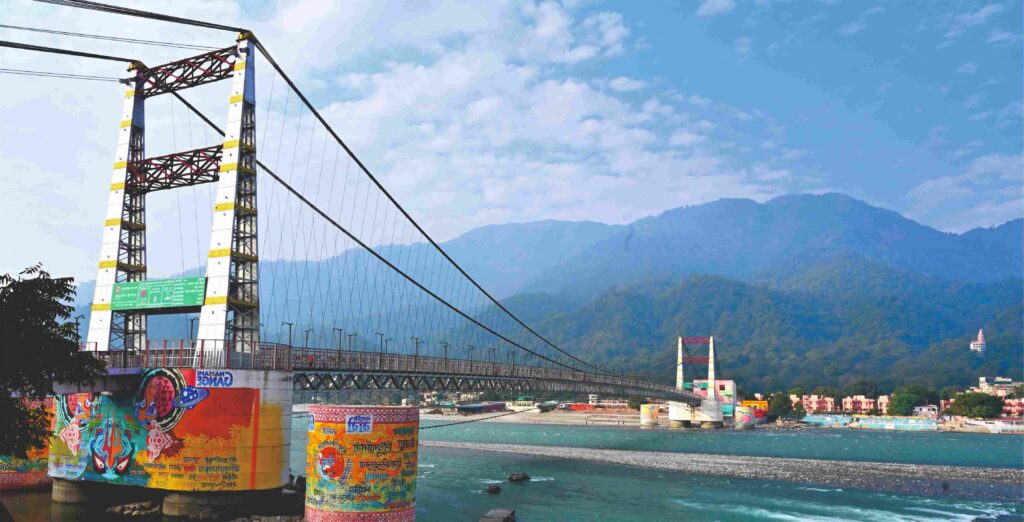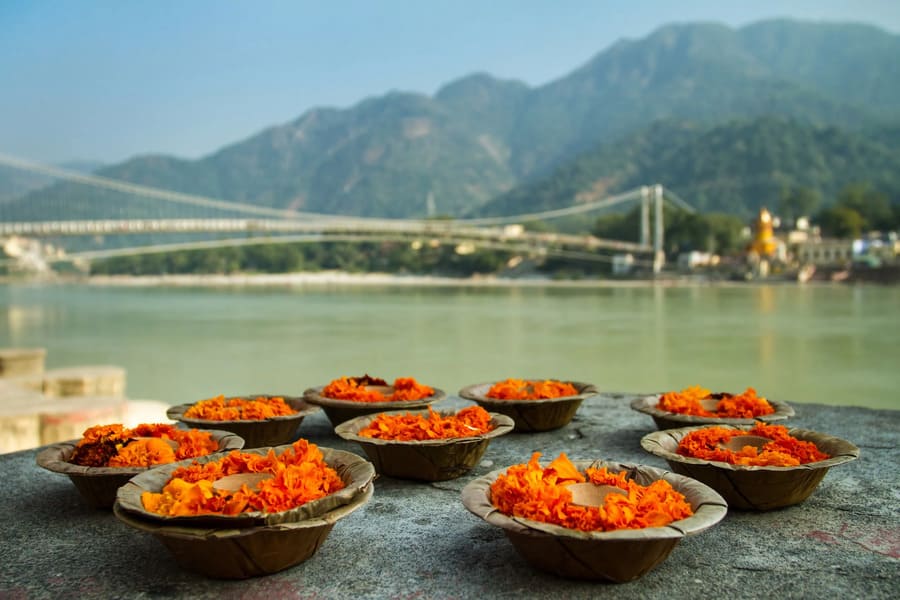
Rishikesh Tourism: Best Places, Time & Travel Guide
Find the full details on Rishikesh Tourism. Complete travel guide, Best places, accommodations, ashrams, scenic landscapes, and thrilling activities.
Nestled in the lap of the majestic Himalayas and adorned by the sacred Ganges River, Rishikesh stands as a spiritual sanctuary and an adventure haven in the Indian state of Uttarakhand. Renowned globally as the “Yoga Capital of the World,” Rishikesh beckons seekers, thrill-seekers, and nature enthusiasts alike. Home to ancient temples, vibrant ghats, and the serene atmosphere of ashrams, it offers a unique blend of spirituality and tranquillity. Beyond its spiritual aura, Rishikesh is a gateway to thrilling white-water rafting, trekking trails, and breathtaking landscapes. Whether you seek inner peace or an adrenaline rush, Rishikesh unfolds a tapestry of experiences against the backdrop of the resplendent Himalayas.
Rishikesh is globally acclaimed for its yoga and meditation centers, drawing spiritual seekers from around the world. The town is a hub for yoga enthusiasts, hosting numerous ashrams and schools where visitors can immerse themselves in the ancient art of yoga, meditation, and holistic well-being. The resonating chants and peaceful ambiance contribute to an ideal environment for self-discovery and rejuvenation.
Rishikesh Tourism is a melting pot of cultures, attracting people from diverse backgrounds. The streets are lined with vibrant markets selling traditional handicrafts, clothing, and spiritual artifacts. The town’s cafes and eateries cater to a global palate, creating an eclectic atmosphere where travellers share stories and experiences.
IN THIS ARTICLE RISHIKESH TOURISM
- Best time to visit Rishikesh
- The best things to do in Rishikesh
- Popular Tourists attractions in Rishikesh
- Popular Temples in Rishikesh
- Where do stay in Rishikesh?
- How to reach Rishikesh?
Best Time to Visit Rishikesh
Nestled in the foothills of the majestic Himalayas, Rishikesh in Uttarakhand beckons travellers year-round with its spiritual aura, adventure offerings, and breathtaking landscapes. Choosing the best time to visit Rishikesh tour, this enchanting destination is crucial to fully immersing yourself in its diverse offerings. Here’s a breakdown of the different seasons to help you plan your visit:

Summer
March to April is a delightful time to visit Rishikesh. The weather is pleasant, with temperatures ranging from 15°C to 30°C (59°F to 86°F). The landscape is lush and green, making it ideal for outdoor activities such as trekking and camping. May to June in Rishikesh can be warm, with temperatures ranging from 20°C to 35°C (68°F to 95°F). It’s a popular time for white-water rafting and other adventure sports due to the warmer weather. Evenings are generally cooler, providing relief from the daytime heat.

Mansoon
The monsoon from July to September brings heavy rainfall to the region, and the Ganges swells with water. While the landscape becomes vibrant and the air is refreshed, outdoor activities may be affected by rain. It’s advisable to check weather conditions and travel advisories during this season.

Winter
Pre-winter, from October to November, is considered one of the best times to visit Rishikesh. The weather is pleasant, with temperatures ranging from 15°C to 25°C (59°F to 77°F). The clear skies and post-monsoon greenery make it an excellent time for sightseeing, yoga, and outdoor activities. Winter from December to February can be chilly in Rishikesh, especially during the evenings and early mornings. Daytime temperatures range from 5°C to 20°C (41°F to 68°F). It’s a quieter time, and the crisp air makes it suitable for those who enjoy cooler weather.
Ultimately, the best time to visit Rishikesh depends on your preferences, whether you prefer the lively atmosphere of peak season, the tranquillity of winter, or the lush landscapes during the monsoon. Choose a time that aligns with the experiences you seek in this spiritual and adventure hub.
The Best things to do in Rishikesh

Rishikesh, nestled along the Ganges River in the foothills of the Himalayas, offers a diverse range of activities catering to spiritual seekers, adventure enthusiasts, and nature lovers. Here are some of the best things to do in Rishikesh tourism:
White-Water Rafting and Activities
Rishikesh beckons adventure enthusiasts with its exhilarating white-water rafting and a spectrum of thrilling activities. The Ganges River, characterized by spirited rapids, sets the stage for an adrenaline-pumping rafting experience. From the heart-pounding rush of navigating challenging rapids to the tranquillity of floating downstream, white-water rafting in Rishikesh offers a dynamic and immersive encounter with nature. The stretch between Shivpuri and Rishikesh is particularly popular.
Attend Ganga Aarti
Witness the mesmerizing Ganga Aarti ceremony at Triveni Ghat, Parmarth Niketan, or other ghats. The evenings come alive with hymns, fire, and the rhythmic flow of the Ganges.
Yoga and Meditation
Rishikesh is known as the “Yoga capital of the world”. Immerse yourself in the spiritual atmosphere of Rishikesh by attending yoga classes or meditation sessions. Numerous esteemed ashrams extend a warm invitation to yoga enthusiasts, offering courses of different durations and costs, ranging from single-day programs to month-long immersions.
Rishikesh Camping Experience
Embarking on a Rishikesh camping experience is an immersive journey into the heart of nature, where the soothing symphony of the Ganges and the crisp mountain air create an enchanting backdrop. Nestled along the riverbanks, the campsites offer a blend of adventure and tranquillity. Picture yourself under the starlit sky, beside a crackling bonfire, sharing stories with fellow campers. With a range of activities, from white-water rafting to yoga sessions, each moment is an opportunity for rejuvenation. Rishikesh camping is not merely a retreat; it’s an unforgettable odyssey, where the embrace of the Himalayas meets the serenity of riverside camps, leaving an indelible mark on the soul.
Bungee Jumping and Adventure Sports
Rishikesh, known for its spiritual aura, also caters to adrenaline enthusiasts with heart-pounding adventure sports. Bungee jumping, a standout among these activities, beckons daredevils to leap off a towering platform at Jumpin Heights. The free fall, accompanied by the rushing sound of the Ganges below, delivers an unparalleled adrenaline rush against the backdrop of the Himalayan foothills.
Beyond bungee jumping, Rishikesh offers an array of adventure sports. Feel the wind in your hair as you soar across the Ganges on a zip line, providing a unique perspective of the river and surrounding landscapes. Rock climbing and rappelling activities challenge climbers against the rugged terrain, providing both physical and mental exhilaration.
Visit Nature and Forest in Rishikesh
Embark on a jungle safari in Rajaji National Park, home to diverse flora and fauna, including elephants, tigers, and various bird species.
Visit Waterfalls near Rishikesh
Embark on a journey of natural wonder as you explore the captivating waterfalls near Rishikesh. Neer Garh Waterfall, hidden in lush greenery, invites you to a tranquil escape. The rhythmic cascade of water creates a soothing ambience, making it an ideal spot for relaxation and rejuvenation. Patna Waterfall is another hidden gem in Rishikesh; it is a very good rush-free destination for picnics and spending time with nature.
Visit Ashrams in Rishikesh
Rishikesh, the “Yoga Capital of the World,” beckons seekers of inner peace and spiritual wisdom to explore its serene ashrams. Nestled along the banks of the sacred Ganges, these spiritual retreats offer a haven for self-discovery and contemplation. Some of the popular ashrams are Parmarth Niketan, Sivananda Ashram, Swarg Ashram, The Beatles Ashram (Maharishi Mahesh Yogi Ashram), Yog Niketan, Omkarananda Ganga Sadan, Sadhana Mandir, and Gita Bhavan.
Popular Tourists attractions in Rishikesh

Rishikesh is a destination that captivates visitors with its spiritual aura, natural beauty, and adventure offerings. Here are some popular tourist attractions in Rishikesh tourism:
Triveni Ghat:
Nestled along the banks of the sacred Ganges River, Triveni Ghat emerges as a spiritual epicentre in the vibrant town of Rishikesh. Steeped in mythology and revered by pilgrims, this hallowed ghat stands at the confluence of three rivers: the Ganges, Yamuna, and Saraswati, giving it the name “Triveni.” As the sun sets, Triveni Ghat transforms into a spectacle of divinity during the Ganga Aarti ceremony. Devotees and visitors gather on the steps, lamps in hand, as priests perform intricate rituals accompanied by soul-stirring hymns.
Laxman Jhula and Ram Jhula:
Laxman Jhula, a suspension bridge spanning the Ganges River, is a landmark in the spiritual town of Rishikesh, Uttarakhand, India. Built in 1929, this iconic bridge is named after Lord Laxman, the brother of Lord Rama, from the epic Ramayana. According to legend, Laxman is believed to have crossed the river on a jute rope at the same spot where the bridge stands today. Laxman Jhula holds immense spiritual significance, surrounded by numerous ashrams, temples, and shrines.
Ram Jhula is an iconic suspension bridge that spans the Ganges River in Rishikesh, Uttarakhand. This architectural marvel, constructed in 1986, is one of the key landmarks in the spiritual town, complementing the tranquility and natural beauty of the surroundings. Ram Jhula connects the Swarg Ashram area on the western bank with the Sivananda Ashram on the eastern bank.
Janki Bridge:
Named after Lord Rama’s wife, Janki Bridge prioritizes both pedestrian and vehicular safety. Spanning 274 meters, it stands as Rishikesh’s inaugural three-lane suspension bridge, offering dedicated paths for walkers and vehicles. Its strategic location near the renowned Ram Jhula makes it a compelling destination, linking Muni ki Reti to Swargashram. With a grand entrance, expansive platform, and comfortable benches, Janki Bridge emerges as an inviting locale for leisurely moments.
The Beatles Ashram (Maharishi Mahesh Yogi Ashram):
An abandoned ashram where The Beatles stayed in the 1960s is now a place for art, meditation, and exploration. Tucked away amidst the tranquil landscapes of Rishikesh, the Beatles Ashram, formally known as the Maharishi Mahesh Yogi Ashram, is a place that resonates with the echoes of a transformative era. In 1968, the legendary band The Beatles, along with other artists, sought refuge in this ashram to delve into transcendental meditation under the guidance of Maharishi Mahesh Yogi.
Parmarth Niketan:
Nestled on the banks of the holy Ganges River in Rishikesh, Parmarth Niketan stands as a beacon of spiritual serenity and yogic wisdom. This renowned ashram, founded by Pujya Swami Shukdevanandji Maharaj, welcomes seekers from around the world, offering a tranquil refuge for spiritual exploration and self-discovery. Parmarth Niketan is globally acclaimed for its enchanting Ganga Aarti. As the sun dips below the horizon, the riverbank comes alive with soul-stirring hymns, rhythmic chants, and the mesmerizing dance of the lamps, creating a divine atmosphere.
Rajaji National Park:
Nestled at the foothills of the Shivalik Range, Rajaji National Park stands as a testament to the rich biodiversity of the region, just a short drive from Rishikesh. Spread across the districts of Haridwar, Dehradun, and Pauri Garhwal, this national park is a haven for nature enthusiasts and wildlife lovers alike. Rajaji National Park is home to a diverse array of flora and fauna, including elephants, tigers, leopards, deer, and a variety of bird species. Explore the wilderness through jungle safaris, offering a chance to spot wildlife in their natural habitat. Jeep safaris and elephant safaris are popular choices for traversing the park’s diverse landscapes.
Neer Garh Waterfall:
Nestled in the lush embrace of Rishikesh’s pristine landscapes, Neer Garh Waterfall stands as a testament to nature’s tranquil beauty. A short trek from the bustling town leads you to this hidden gem, where the melodious symphony of cascading water echoes against the verdant backdrop of the Himalayan foothills. A secluded waterfall accessible by a short trek, surrounded by lush greenery. The trek to Neer Garh is a moderate-level adventure, making it accessible to both novice and experienced trekkers. The journey itself becomes a part of the immersive experience.
Rishikesh Ganga Beach
Rishikesh Ganga Beach is a serene retreat that captivates visitors with its scenic beauty and spiritual aura. This tranquil stretch of the Ganges, also known as the Ganga Beach or Ganga Ghats, holds a special place in the hearts of pilgrims and seekers who flock to its sacred waters. The gently flowing Ganges invites visitors to partake in various activities. Many come to the riverbanks for meditation, yoga, and peaceful contemplation against the soothing backdrop of the flowing waters.
More Tourist Places in Rishikesh
Sacred Havens: Popular Temples in Rishikesh

Rishikesh, a spiritual gem nestled in the Himalayan foothills, is adorned with temples that echo centuries of devotion and serenity. Here are some of the most revered temples in this holy town:
Bharat Mandir:
Nestled in the spiritual haven of Rishikesh, Bharat Mandir stands as a testament to timeless devotion and architectural finesse. Revered as the oldest temple in the town, this sacred edifice holds within its ancient walls a rich tapestry of religious significance and cultural heritage. Dedicated to Lord Vishnu, Bharat Mandir is not merely a place of worship; it is a living testament to the enduring spirituality that has graced the banks of the holy Ganges for centuries. Constructed by Adiguru Shankaracharya in the 12th century, Bharat Mandir carries an air of antiquity, marked by intricate carvings and adorned with ancient scriptures that narrate tales of divine lore.
Neelkanth Mahadev Temple:
Nestled amidst the lush forests of the Himalayan foothills near Rishikesh, the Neelkanth Mahadev Temple stands as a testament to devotion and spiritual allure. Dedicated to Lord Shiva, this ancient temple is not just a place of worship; it is a harmonious fusion of natural beauty, mythological significance, and architectural elegance. Legend has it that this is where Lord Shiva consumed the divine poison during the churning of the ocean, turning his throat blue and earning the name “Neelkanth,” or the Blue-Throated One.
Kunjapuri Devi Temple:
Perched atop a hill in the celestial realms of Rishikesh, the Kunjapuri Devi Temple stands as a beacon of divinity and panoramic beauty. Dedicated to Goddess Durga, this sacred shrine offers not only a spiritual haven but also a vantage point that unveils the enchanting tapestry of the Himalayas and the meandering Ganges below. Embarking on the journey to Kunjapuri is not just a pilgrimage; it is a soulful ascent to tranquility, where devotees and seekers alike find solace amidst the serene grandeur of nature and the divine.
Raghunath Temple:
Dedicated to Lord Rama, this sacred edifice is a revered pilgrimage site that draws devotees and seekers alike. Located in the heart of Rishikesh, the temple exudes an aura of tranquility, offering a respite from the worldly hustle and inviting visitors to immerse themselves in spiritual contemplation. Adorned with vibrant sculptures and steeped in mythology, the Raghunath Temple is not merely a religious site but a symbol of the spiritual heritage that graces the foothills of the mighty Himalayas.
Trayambakeshwar Temple (Tera Manzila Temple):
Nestled on the eastern bank of the holy Ganges River, the Trayambakeshwar Temple, also known as Tera Manzila Temple, stands as a revered sanctuary in the spiritual tapestry of Rishikesh. Dedicated to Lord Shiva, this ancient temple is a testament to divine grace and architectural brilliance. The Trayambakeshwar Temple holds not only religious significance but also captivates devotees and visitors with its panoramic views of the enchanting surroundings.
Shatrughna Mandir:
Nestled in the spiritual heart of Rishikesh, Shatrughna Mandir stands as a testament to the town’s rich cultural heritage and reverence for Lord Rama’s brothers. This sacred temple, an integral part of the Raghunath Temple complex, pays homage to Lord Shatrughna, the valiant brother in the epic Ramayana. Adorned with vibrant sculptures and intricate carvings, Shatrughna Mandir offers devotees and visitors alike a serene retreat for prayer, contemplation, and an immersive experience in the divine aura of Rishikesh.
Virbhadra Temple
Nestled amidst the serene landscapes of Rishikesh, the Virbhadra Temple stands as a testament to the town’s rich spiritual tapestry. Dedicated to Lord Shiva, this sacred abode of divinity beckons devotees and seekers with its tranquil ambiance and historical significance. Surrounded by the lush greenery of Rajaji National Park, Virbhadra Temple not only encapsulates architectural grace but also provides a serene retreat for those seeking solace and spiritual connection.
How to reach Rishikesh?
To reach Rishikesh, you can consider the following options:
By Air:
- The nearest airport is Jolly Grant Airport in Dehradun, which is approximately 35 kilometres away from Rishikesh.
- You can fly to Jolly Grant Airport and then take a taxi or bus to reach Rishikesh.
By Train:
- Rishikesh has its railway station, but it’s a small station with limited connectivity. The nearest major railway station is Haridwar, which is well-connected to major cities in India.
- From Haridwar, you can take a train or hire a taxi to reach Rishikesh, which is about 25 kilometers away.
By Road:
- Rishikesh is well-connected by road, and you can reach there by bus, car, or motorcycle.
- It’s approximately 240 kilometers from Delhi, and you can take a bus or drive via NH58.
By Bus:
- There are regular bus services from various cities in North India to Rishikesh.
- You can take a state-run or private bus depending on your location.
By Car:
- If you prefer a more comfortable and flexible journey, you can drive to Rishikesh. The roads are generally good, and the scenic views along the way make for a pleasant trip.
How to get around in Rishikesh?
Many individuals prefer navigating Rishikesh using Vikrams (auto-rickshaws) and jeeps, although taxis also serve as a viable alternative. Here’s a guide on transportation in the area:
- Walking:
Rishikesh is a pedestrian-friendly town, especially in the central and riverfront areas. Many of the popular attractions, markets, and cafes are within walking distance. - Auto Rickshaws and Taxis:
Auto rickshaws and taxis are available for short-distance travel or when you need a more comfortable ride. Negotiate fares beforehand or ask the driver to go by the meter. - Cycle Rickshaws:
In some parts of Rishikesh, especially around the markets and narrower streets, you may find cycle rickshaws. They are a slower but eco-friendly option for short distances. - Two-Wheelers and Bicycles:
Renting a scooter, motorcycle, or bicycle is a popular choice for exploring Rishikesh and its surroundings. Many rental services are available in the town. - Public Buses:
Public buses operate within Rishikesh and connect it to nearby towns and attractions. It’s an economical option, but schedules may vary. - Shared Jeeps:
Shared jeeps or small vans are commonly used for transportation to nearby destinations or towns. They operate from the main bus stand. - Private Car Hire:
You can hire a private car with a driver for more comfort and convenience, especially if you plan to visit nearby tourist spots or need a dedicated vehicle. - Boats:
If you need to cross the Ganges River, there are boat services available. This is particularly useful if you’re staying on the other side of the river.
When moving around in Rishikesh, keep in mind that the town has a vibrant and spiritual atmosphere, so be respectful of local customs and practices. Always confirm transportation details and negotiate fares when using auto rickshaws or taxis.
Frequently Asked Questions (FAQs) on Rishikesh Tourism:
What makes Rishikesh tourism popular?
Rishikesh is renowned for its spiritual significance, being a hub for yoga and meditation. Additionally, its location on the banks of the Ganges River and proximity to the Himalayas make it an ideal destination for adventure seekers.
What is the best time to visit Rishikesh?
The best time to visit Rishikesh is from September to November and then from March to early June. During these months, the weather is pleasant, and outdoor activities are more enjoyable.
Are there specific rules for visiting the ashrams in Rishikesh?
While each ashram may have its own rules, it’s generally advised to dress modestly, maintain silence in certain areas, and adhere to the ashram’s schedule and code of conduct.
How can one participate in the Ganga Aarti ceremony?
The Ganga Aarti ceremonies are held at various ghats in Rishikesh, such as Parmarth Niketan and Triveni Ghat. Visitors can join the ceremonies, usually held in the evenings, and witness the ritual. It’s recommended to arrive early for a good view.
What adventure activities are available in Rishikesh?
Rishikesh Tourism is a hub for adventure sports. White-water rafting, trekking, camping, bungee jumping, and paragliding are popular activities. Many adventure operators offer packages catering to different preferences and skill levels.
How far is Rishikesh from Haridwar, and how can one travel between the two?
Rishikesh is approximately 25 kilometres from Haridwar. One can travel between the two towns by road, taking a bus, taxi, or auto rickshaw.
Can one learn yoga in Rishikesh, and are there specific courses available for beginners?
Yes, Rishikesh is a prominent destination for learning yoga. Many ashrams and schools offer yoga courses for practitioners of all levels, including beginners. It’s advisable to research and choose a reputable institution.


